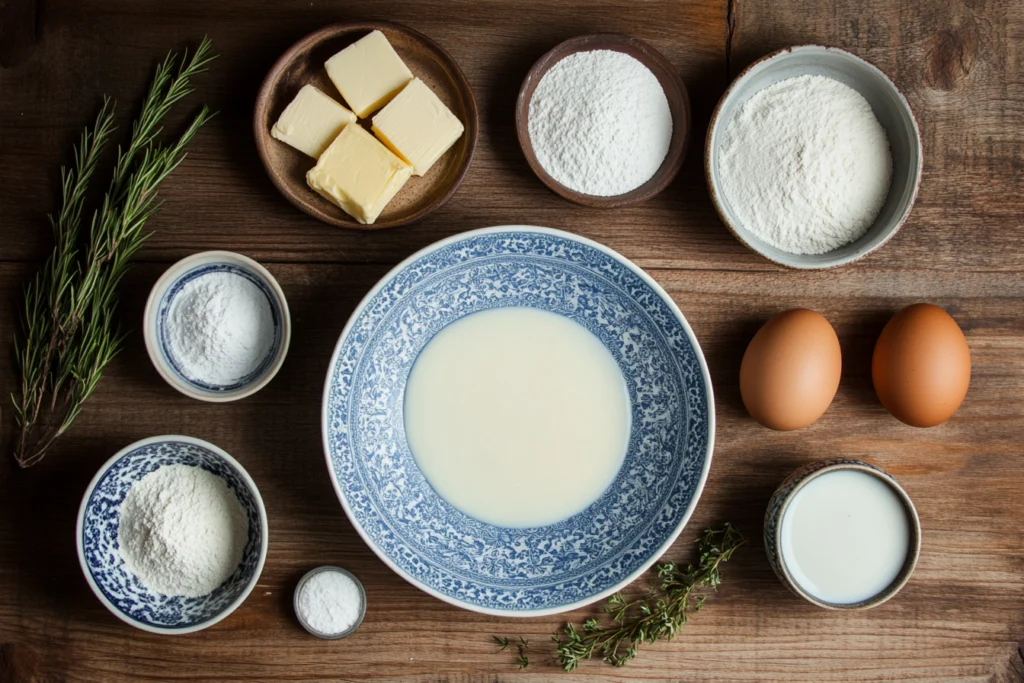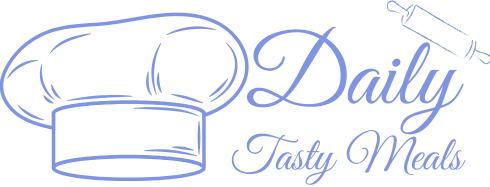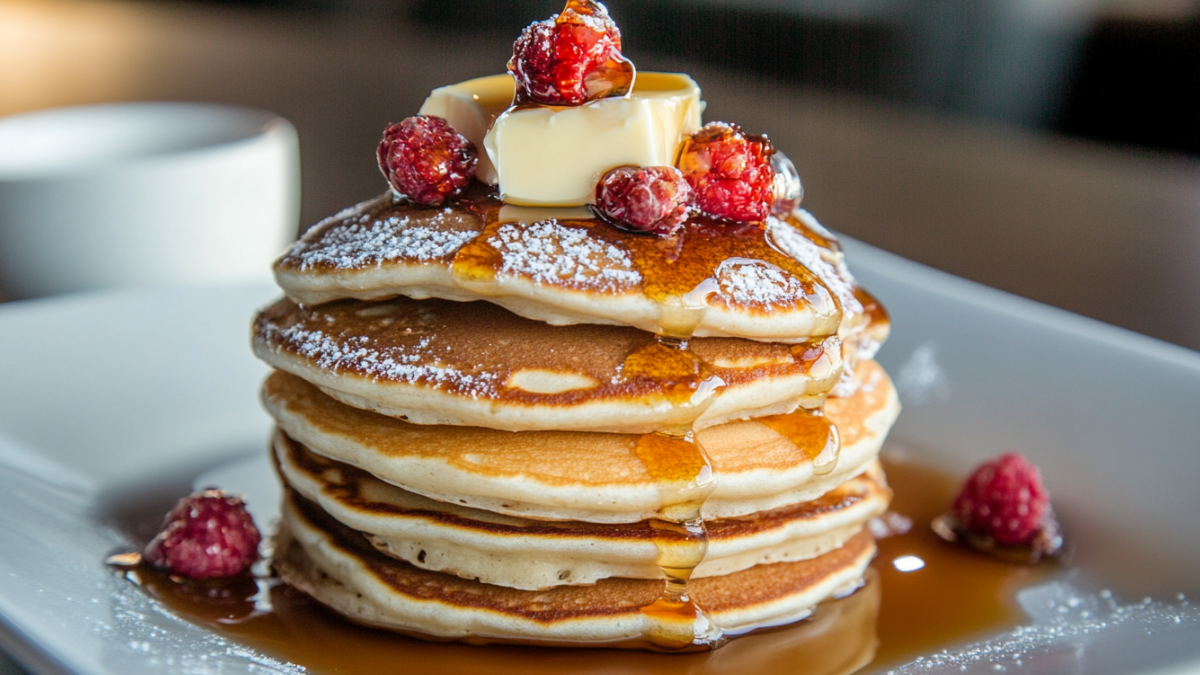Martha Stewart Pancake Recipe: A Guide to Fluffy Perfection
If you’re a breakfast lover, you’ve probably heard of the Martha Stewart pancake recipe. It is known for being simple and giving amazing results. This recipe promises pancakes that are soft, fluffy, and full of flavor. They’re perfect for any morning meal.
Table of Contents
The History Behind Martha Stewart Pancake Recipe
Martha Stewart has been a household name in the culinary world for decades, known for her attention to detail and ability to make even the simplest dishes extraordinary. Pancakes, often considered a staple of American breakfasts, hold a special place in her recipe repertoire. The Martha Stewart pancake recipe embodies her philosophy of turning ordinary ingredients into something memorable.
The origins of this recipe trace back to Martha’s early days of experimenting with traditional pancake formulas. Over the years, she refined it, focusing on achieving the ideal balance of fluffiness and flavor. The recipe quickly became a favorite among her fans, not only because of its delicious results but also because of its simplicity.
Pancakes have a long history themselves, dating back to ancient Greece and Rome. The American version, however, took shape in the 18th century when fluffy pancakes became synonymous with home-cooked breakfasts. Martha’s contribution to this tradition has been making it accessible and foolproof for everyone.
Her recipe stands out because of its adaptability. Whether you’re cooking for children, experimenting with healthier ingredients, or looking for an indulgent treat, this recipe can easily be modified to suit your needs. It is this versatility that has cemented the recipe’s place in American kitchens.
Additionally, Martha Stewart’s pancake recipe has inspired countless home cooks to elevate their breakfast game. Through her cookbooks, TV shows, and online platforms, she has demonstrated that great pancakes don’t require complex techniques. Instead, they require high-quality ingredients and a bit of patience.
Why Choose Martha Stewart Pancake Recipe?
Martha Stewart’s pancake recipe is popular because it’s easy to make and tastes fantastic. Unlike many other recipes, it focuses on making pancakes that are light and fluffy. Whether you’re making breakfast for your family or hosting brunch for friends, these pancakes will impress everyone.
For even more ideas, try the Cracker Barrel Pancake Recipe for a unique twist on traditional pancakes. Similarly, the Chocolate Chip Pancake recipe is a must-try for anyone with a sweet tooth.
Essential Pancake Tools for Success
While the Martha Stewart pancake recipe itself is straightforward, having the right tools can make the process even easier. From mixing the batter to cooking perfect pancakes, the equipment you use plays a significant role.
First and foremost, you’ll need a mixing bowl and whisk. A large, sturdy bowl gives you ample space to mix the ingredients without making a mess. A whisk is ideal for combining the wet and dry ingredients, ensuring the batter is smooth and lump-free.
Next, a non-stick skillet or griddle is essential for cooking pancakes evenly. The non-stick surface prevents the batter from sticking, making flipping easier. A griddle is especially useful if you’re cooking for a crowd, as it allows you to cook multiple pancakes at once.
A measuring cup or ladle is another must-have tool. This ensures that each pancake is the same size, giving your stack a professional appearance. For smaller pancakes, a cookie scoop works perfectly.
Lastly, consider using a spatula designed for flipping pancakes. A thin, flexible spatula helps you flip the pancakes without breaking them. Look for one that’s heat-resistant and easy to clean.
Having these tools ready will not only simplify the cooking process but also ensure your pancakes turn out beautifully every time.
Ingredients Breakdown
The secret to perfect pancakes lies in the ingredients. Here’s what you’ll need and why each one is important:

- Flour: The main ingredient that gives the pancakes structure.
- Sugar: Adds just the right amount of sweetness.
- Baking Powder: Helps the pancakes rise and makes them fluffy.
- Milk: Keeps the batter smooth and helps mix everything together.
- Eggs: Makes the pancakes rich and soft.
- Butter: Adds flavor and prevents sticking.
If you want a different take on pancakes, check out the Mastering Krusteaz Pancake Mix Recipes, which provides tips for using pre-made mixes.
Why Fluffiness Matters in Pancakes
When it comes to pancakes, fluffiness is the ultimate goal. But have you ever wondered why it matters so much? Fluffy pancakes are a hallmark of comfort food because they’re light, airy, and melt in your mouth. This texture makes them more enjoyable to eat compared to dense, heavy pancakes.
The key to fluffiness lies in the batter. Using ingredients like baking powder creates bubbles in the batter, which expand when heated. This process gives the pancakes their signature rise. However, achieving fluffiness isn’t just about the ingredients; it’s also about how you handle the batter.
For instance, overmixing the batter can break down the air bubbles, leading to flat pancakes. That’s why the Martha Stewart pancake recipe emphasizes mixing the ingredients gently and just until combined. Letting the batter rest for a few minutes before cooking also helps, as it allows the gluten in the flour to relax, further enhancing the texture.
Fluffiness doesn’t just affect the eating experience; it also impacts how well the pancakes absorb toppings like syrup and butter. A fluffy pancake can hold more syrup without becoming soggy, making each bite a perfect balance of flavors and textures.
Step-by-Step Preparation Guide
Making these pancakes is straightforward if you follow these steps:
- Mix the Dry Ingredients
- In a large bowl, combine the flour, sugar, and baking powder.
- Combine the Wet Ingredients
- In another bowl, whisk together the milk, eggs, and melted butter.
- Mix Both Together
- Slowly add the wet ingredients to the dry ones. Stir gently until combined, but do not overmix.
- Cook the Pancakes
- Heat a non-stick skillet or griddle over medium heat. Pour small amounts of batter into the pan. When bubbles form on the surface, flip the pancakes and cook until golden brown.
Cooking Techniques for Best Results
Even though this recipe is simple, a few tips can make a big difference:
- Always preheat your pan to ensure even cooking.
- Use a non-stick pan or griddle for easy flipping.
- Measure your batter to make pancakes the same size.
- Cook at medium heat so the pancakes don’t burn.
Nutritional Benefits of Pancakes
Pancakes are often considered indulgent, but they can be surprisingly nutritious when made with the right ingredients. The Martha Stewart pancake recipe strikes a balance between taste and health, offering several benefits.
First, pancakes made from scratch contain fewer preservatives compared to store-bought mixes. This allows you to control the ingredients and make healthier choices. For example, you can use whole wheat flour instead of all-purpose flour to increase fiber content.
Additionally, pancakes are a great source of carbohydrates, which provide energy to fuel your morning. Adding ingredients like eggs and milk boosts the protein content, helping you feel full longer.
For added nutrition, consider mixing fruits like blueberries or bananas into the batter. These add natural sweetness, vitamins, and antioxidants. Nuts and seeds are another excellent addition, offering healthy fats and a satisfying crunch.
Serving Suggestions and Toppings
To make your pancakes even better, try these serving ideas:
- Classic Toppings: Butter and maple syrup.
- Fresh Additions: Add fruit like berries, bananas, or peaches.
- Indulgent Extras: Use whipped cream, chocolate chips, or a drizzle of nut butter.
For something fruity, try the Bisquick Blueberry Muffins, which pair wonderfully with pancakes.
Variations of Martha Stewart’s Pancake Recipe
This recipe can be adjusted to suit your preferences:
- Buttermilk Pancakes: Use buttermilk instead of regular milk for a tangy flavor.
- Whole Wheat Pancakes: Swap white flour for whole wheat flour to make a healthier option.
- Blueberry Pancakes: Add fresh or frozen blueberries for extra sweetness.
Creative Pancake Pairings for Every Meal
Pancakes aren’t just for breakfast. With the right pairings, they can be enjoyed at any time of day. Whether you’re looking for a savory option or a decadent dessert, there are countless ways to serve pancakes.
For breakfast, pair pancakes with crispy bacon or scrambled eggs. This classic combination offers a mix of sweet and savory flavors that’s hard to beat.
For lunch or dinner, try serving pancakes alongside fried chicken for a Southern-inspired meal. You can also use pancakes as a base for mini sandwiches, layering them with cheese, turkey, or avocado.
FAQs
Can I make the batter ahead of time?
Yes, but it’s best to use it within 24 hours.
What can I use instead of eggs?
You can try applesauce or a flaxseed mix as an egg substitute.
How do I store and reheat pancakes?
Keep them in an airtight container in the fridge. Reheat them in a toaster or oven.
Can I freeze pancakes?
Absolutely! Freeze them in a bag with parchment paper between each pancake.
How can I keep pancakes warm while cooking more?
Place them on a baking sheet in a 200°F oven until all are ready to serve.
Conclusion
The Martha Stewart pancake recipe is a classic that anyone can enjoy. Thanks to its simple instructions and high-quality results, it’s perfect for beginners and seasoned cooks alike. Give it a try and enjoy the fluffiest, tastiest pancakes ever!

